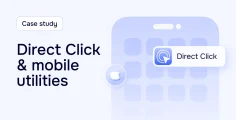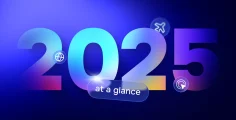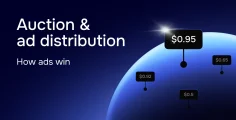Website traffic runs like a river and starts with a single drop — a user. Over time, the river grows bigger, you build a dam on its way, which generates profit for you.
But what if you can’t help but want more? What if the dam doesn’t work to its full capacity? What should you do as a publisher to improve your website output?
A simple answer is to boost your volume of traffic. No matter how progressive the dam is, it can’t make money out of thin air — you need a bigger flow. But how do you amplify the traffic volume?
That’s where our new article comes into play. Learn how to increase the traffic volume your website generates. We’ve compiled tips and tricks, related to design, SEO, page speed, and so much more.
All the websites are unique, which is why you don’t have to follow every tip to the letter. Pick the ones you deem the most optimal and let’s get started.
A Dozen of Technical Tips to Hasten Your Website
Sometimes, you need to tweak just a few elements to speed up your website. We’ve gathered 12 key points, related to performance improvement. When doing optimization, don’t forget to optimize for mobile phones separately, as these devices tend to work slower than desktops. Here are a dozen tips to speed up your website:
- Optimize images. Compress images without compromising quality. Use appropriate formats like JPEG for photographs and PNG for graphics.
- Minimize HTTP requests. Reduce the number of elements on a webpage (images, scripts, CSS files) to minimize HTTP requests. Combine multiple files into one where possible.
- Enable compression. Use GZIP compression to reduce the size of your CSS, HTML, and JavaScript files, thus reducing load time.
- Leverage browser caching. Set up caching headers to instruct browsers to store static files locally, reducing the need for repeated downloads.
- Enable content delivery networks (CDNs). CDNs distribute your website content across multiple servers worldwide, reducing latency and speeding up page load times for users across different geographical locations.
- Minify CSS, JavaScript, and HTML. Remove unnecessary characters like comments, spaces, and line breaks to reduce file size.
- Optimize CSS delivery. Avoid render-blocking CSS by inline critical CSS or deferring non-critical CSS. This ensures faster rendering of the webpage.
- Reduce server response time. Optimize server response time by upgrading hosting, using caching, and minimizing the use of server-side scripts.
- Prioritize above-the-fold content. Load critical content first to improve perceived page speed. This can be achieved by optimizing HTML structure and using asynchronous loading for non-essential elements.
- Monitor and optimize performance. Continuously monitor website performance using tools like Google PageSpeed Insights or GTmetrix. Identify bottlenecks and optimize accordingly.
- Implement lazy loading. Load images and other non-critical resources only when they come into the viewport, rather than loading everything at once.
- Optimize fonts. Use web-safe fonts and limit the number of font styles to reduce HTTP requests and speed up rendering.
Content Is at the Foundation
Let’s talk about copywriting-related tips. After all, no blog is possible without some sort of content.
Perfect Writing
Content is king — that’s what Bill Gates said in 1996 in his essay. None of the following tips are possible without content. To get more users, you need more content of quality. It doesn’t mean working your fingers to the bone, but it does have to get as much exposure as possible. Consider this:
- Regularly publish blog posts, videos, announcements, etc.
- Share your content on social media for maximum coverage, e.g., Instagram, Twitter, X
- Guest post on other websites in your niche to reach new audiences.
Prioritize evergreen topics, because they spark interest throughout the year. Although event marketing can boost traffic quickly, this influx fades away just as fast. You won’t catch up with the latest trends forever, which is why it’s better to invest your time and efforts in relatively timeless topics first.
Headline is your best bet. David Ogilvy, an advertising tycoon, is famously known for saying:
“On the average, five times as many people read the headline as read the body copy. When you have written your headline, you have spent eighty cents out of your dollar.”
Make sure your headline is value-centric, specific, summarizes the content, and is compelling. If that sounds like a lot for a 60-characters-long field, consider using sub-headlines.
SEO Makes Your Content Stand Out
Search Engine Optimization (SEO) ensures your content of quality is showcased accordingly. As a rule of thumb, you should write as if speaking to your friends, even when dealing with search engine crawlers.
These web spiders browse through the majority of the content found online and rank it. That’s why it’s important to differentiate the good bots from the bad ones. Spam and click fraud bots are notorious examples, which are better off blocked. Search engine, copyright, and site monitoring bots, on the other hand, are helpful.
Remember us saying about the 60-characters-long and compelling headline earlier? Now is the time to upgrade it with power, emotion, and uncommon words:
- Power: breakthrough, last chance, terrific
- Emotion: mired, wanton, wicked
- Uncommon: best, photos, world
Consider adding numbers and brackets in your headlines for extra engagement, e.g., (7 Tips For Publishers).
Although headlines are crucial, they can appear misleading if there is no content to backbone them. Ponder over placing a specific keyword once per 1,000 words.
Also, don’t forget to add internal links, which benefit not only SEO but also offer a user more reasons to stay.
Finally, increase your exposure by building backlinks. They’re links from other websites that direct users to yours. Quality backlinks from reputable sites not only bring direct traffic but also improve your site’s visibility and ranking on search engines, making it easier for people to find you.
“Apple of One’s Eye”
Add visuals, period. Random pictures, infographics, charts — anything goes, as long as it facilitates understanding and tells your story visually. There’s a good reason why people in general prefer videos and video games to reading books.
You don’t have to be a designer to find royalty-free pictures online, e.g., Freepik or Unsplash.
Talking about AI, consider using Midjourney, Canva, or Freepik online image generators to get good enough pictures fast.
Finally, you can always hire a designer for you, using such platforms as Fiverr or 99designs.
Regularly Update Content
Whether you have a news portal or a sports-related blog, update your content regularly. Besides updating it, make sure to inform your users explicitly about new materials.
If you run out of ideas, ask ChatGPT or other neural networks for assistance. Search social media and the blogs of competitors for new topics.
Marketing and Promotion
Making content is usually not enough, because it has to be visible. This is where various promotional channels come to the rescue.
Join RollerAds to experience efficient promotion firsthand. Try out our best converting Push notifications and PopUnders with some of the most flexible targeting settings.
Social Media: Every Bit Helps
When promoting content, social media are to be reckoned with: 4.95 billion people use them daily, which is 61.4% of the global population. Moreover, about 80.8% of all 18+ people frequent social media.
At the same time, the audience is not homogeneous. Thus, you need to know your audience portrait and pick the social media platforms accordingly, to grab as many potential prospects as possible. For example, Instagram is more suited for people under 30, while LinkedIn works better for 30+.
Make sure to integrate share-on-social-media buttons, so that the users can easily save your blog posts and refer to them when needed.
Push Notifications and Email
While working with the already existing traffic won’t generate new users on its own, it helps to reduce bounce rate, improve user experience from your website, and spread out positive word-of-mouth about your website.
Retaining a user can be five times cheaper than acquiring one. Moreover, people tend to have a plethora of alternatives nowadays. That’s why regular reminders help to keep your website afloat and attract users, who might be swayed elsewhere otherwise.
This goes beyond just Push notifications and includes email newsletters. In fact, such letters are ideal for weekly digests: enabling you to squeeze in more info than Push notifications allow without becoming long-reads at the same time.
Miscellaneous Promotional Channels
Not only marketers engage in advertising. You can advertise your blog, news website, streaming service, or any other website too. Paid promotions might be more costly than the other options, but they do pop up first in search engines.
Consider using thematic forums to spread the word about your website. They are an ideal ground to find enthusiasts and peers.
You can also engage in cross-promotion with other publishers, ensuring you both tap into relatively new audience segments. You don’t have to specialize in the same niche; it might actually be better to partner with people from other spheres. For example, assume you specialize in sports broadcasting; why not team up with news websites or sweepstakes blogs?
Analytics: Know What’s Going On
Over time, your blog grows. However, not all the content is equally useful or helpful. Thus, you need to figure out the best pieces of content and capitalize on them.
A reliable way to discover top performers is to use an analytical tool, like Google Analytics and Semrush. Google Analytics provides insights into website performance, marketing effectiveness, and user behavior. Trend measurement, predictive analytics, and individual behavior tracking help to tailor content and retain the users better. It’s also beneficial for SEO.
Conclusion
At the end of the day, website visitors appreciate superior customer support and genuine care. It’s hard to find a business that excels at customer support and fails to make a profit and meet the required KPIs.
The user won’t remember what they wore or how they arrived at your website, but they will remember how they were treated. Also, no user is an idiot, which is why we encourage you to show respect no matter what.
It encompasses perfecting the content by removing excessive words, pondering over headlines to grab attention, adding visuals for greater influence, etc. Remember, two heads are better than one, so attend affiliate conferences to foster long-term partnerships. Your partners care for your audience as much as you do, at least this is the case for RollerAds.





